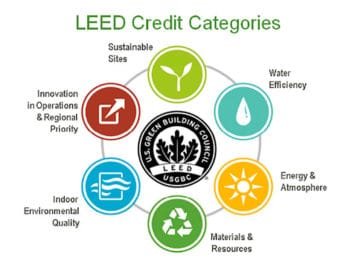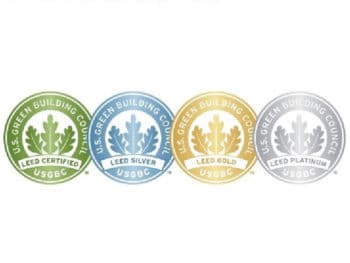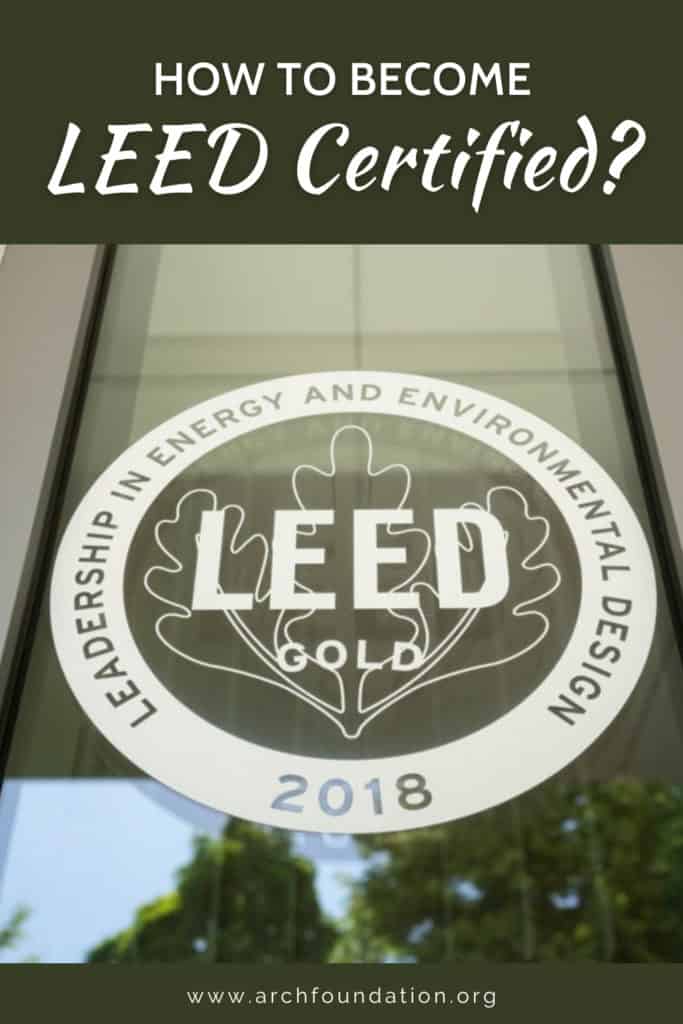How to Become LEED Certified?
If you have hands-on experience working on buildings, and considering getting an industry-related certification, then you may want to consider becoming LEED certified.
With LEED certification, you could brand yourself as a professional with experience in the field of green building design and construction.
As you have already imagined, there are requirements for getting LEED accreditation. While you will have to have a background in architecture or building construction, there are still opportunities for those without any form of experience.
Wondering what it takes to become LEED certified? Before I get into the details of all that is required of you, lets first discuss some important terms before we continue with the piece.
What Is the Meaning of LEED?

Often confused with LEAD, the term LEED is an abbreviation for Leadership in Energy and Environmental Design. It is the rating system used globally for the recognition of green buildings.
A LEED plaque in front of a commercial building shows that it is eco-friendlier than others. The need for greener houses to reduce the carbon footprint on the environment has made many building professionals seek certification to improve their qualifications. You can learn more about LEED from this short video by USGBC.
Who Can Be LEED Certified?
As you may have already imagined, LEED certification isn’t for everyone. So who then is it for? You might ask.
The truth is anyone can take the exams and scale it if they prepare adequately. Still, for the certification to be of value, you should be interested in a career in architecture or building construction.
You will need to be LEED accredited to be able to deliver projects that are LEED-certified. So if that is something you are interested in, you want to get yourself ready to sit for an exam.
There are two variations of the certification program, and you need to learn about them before enrolling to sit for the test. You could check out this short video to get more additional info.
Levels of LEED Accreditation
The two different levels are the LEED Green Associate program and the LEED AP.
LEED Green Associate
This program is considered as an entry-level into the green building space. There is a lot of benefits that come with this title. You get to brand yourself as a professional who has updated knowledge of green building practices. You only get to take one test, and if you pass it, you get certified. You can find out more in this short video.
LEED AP
As you may have imagined, the LEED AP is a more advanced qualification. It is mostly sort after by professional architects who want to position themselves as experts in green building. Unlike the Green Associate, there are five different levels in the AP program. You can learn more from this video about the AP program.
The tests differ from each other in their requirements. But just in case you are wondering about the different types, you can find a quick summary below.
- BD+C: Short for building design and construction. This accreditation paints you as someone with experience planning, designing, and creating green buildings.
- ND: This one stands for neighborhood development. With this, you get to plan and develop living areas for neighborhood communities.
- ID+C: Interior decor and construction, means that you have what it takes to fashion out living spaces for different types of buildings.
- Homes: With this certification, you get to work on green homes. This includes coming up with plans and design for a minimal energy home.
- O+M: Stands for operations and management. With this, you can update existing structures and get them to be more sustainable.
While there aren’t many restrictions with the GA program, you have to be 18 years of age and have a Green Associate certification to be able to sit for AP tests.
In an era where folks are becoming eco-friendlier, you will agree that it pays to be certified as a green building construction expert. This could help make your credentials more attractive to an employer, plus also bump up your pay.
So what does it take to get LEED certified?
What Are the Requirements to Get Certified?
Like I mentioned earlier, you will need to be 18 years and older plus also have a LEED Green Associate accreditation before you can go for the AP program. But if you are starting, all you need is to pay the enrolment fees and sit for a test. You can learn more from this short video about the requirement of becoming LEED certified.
How to Apply?
Applying to get LEED-certified isn’t as stringent as you might think. The entire process is broken into steps below.
- Create a user account on the official site here.
- Login to your user account and head over to the Credentials section.
- Once there, select the exam you intend to sit for and fill out the registration requirements and submit them.
- Schedule an exam date that is close to your location, and that’s all.
Like I said earlier, getting the accreditation is not all that much of a hassle. There are practice materials for all the tests to help you get ready and have an idea of what you should expect on the test day.
While it may be easy to register and sit for the test, a lot of people find it hard to get themselves registered and pass the exams, even after a couple of trials.
So how can you enhance your chances of passing the exam in your first or second sitting?
The answer is simple. You need adequate preparation. You can find some useful tips in this simple guide put together by me.
Registering for the Exams
The steps to get registered is the same for both types of program. The whole registration procedure is done online, so you don’t have to travel for any reason. You will only have to visit the test center on your exam day.
The simple breakdown below can help you get registered for your exams.
- Login to your USGBC account or create one if you don’t have your profile setup already.
- Navigate to the credentials sections and select the Green Associate program.
- You will be directed to a page where you have to provide information such as your preferred exam date and location.
- The complete your registration process, you will need to pay the exam fees.
Preparing for the Exam
Once you have finished your registration and have received your exam details with the date, location, and time the next step will be to prepare adequately.
Your preparation will involve a lot of studying if you intend to pass your exam on your first attempt. You will be faced with a two-part test of 100 questions each that must be completed in two hours of you are sitting for the Green Associate exam.
While you may want to get your hands on all the free resources that you can find, it may also be wise to invest in a few paid courses. There are complete study guides prepared by experts who have written the tests and helped others as well.
Some guides include audio and video lessons that are easy to understand, so you may want to research available resources.
You want to give yourself ample time to get prepared. Waiting until a few days before your test to start gathering materials may not be advisable. A couple of weeks or months is enough time to get ready to ace the accreditation exams.
What to Expect on the Test Day?
On the D day, you want to do all you can to get to the venue an hour or 45 minutes before the test commences. Arriving late could cost you your seat at the place, so you want to arrive with time to spare. On arrival, you will meet with the staff of the test station who will show you to a workstation to begin your examination.
Once the test commences, you are to remain in your seats and will need permission to be excused. It is of no point trying to look for avenues to cheat. There are usually security systems installed at the centers to assist with the test supervision. So this is more reason why you want to prepare accordingly.
There is no time pauses for breaks. And you have two hours to answer 100 questions. So if you must leave the hall, it had better be worth it. A valid ID will be required of you with your photograph and signature before taking your seats.
What Is the Nature of the Examination?
You should expect to write a computer-based test. You will need to know your way around a computer to be able to navigate around the screen. The exam is usually in the form of multiple-choice questions. You will have to select the right answer(s) from the options.
You are timed and recorded by the computer. You can skip questions and make changes to your answers. While you have two hours to answer the questions, there is a 10-minute optional tutorial at the start of the test and another 10 minutes closing survey at the end.
The test aims to find out how much you know about green buildings and generally ask questions centered around.
- The process of applying LEED
- Project site circumstances
- Water management
- Project systems and the impact of energy
- The management, acquisition, and installation, of project materials
- How Involved Stakeholders are in Innovation
- Public Outreach and Project Surroundings
- Synergistic Opportunities between various LEED strategist
NB: You must be at the venue on time and attempt all questions. If for any reason, you miss the exam or exit the hall, you won’t be able to restart the test. Also, there is no refund of payment once the process has started.
Tips for Passing the Exam

For you to be able to ace the test, you need to score more than 170 points. The rating scale for scoring LEED accreditation exams starts between 120 and 200 points.
With adequate preparation, it is possible to score over 170 points. It is even easier if you have a background in green building practices. The questions are not all that technical, and if you do your homework, you should quickly find the answers in the multiple-choice questions.
At the end of the test, you will be presented with your results right on the screen. You should also receive a copy via the email you used during registration.
Three days after taking your accreditation exams, your USGBC account will be updated with your results. And if you scale the procedure, you will get your badge appearing on your profile.
Once you pass the accreditation process, you can make use of the badge and include the title “LEED® Green Associate™” in your resume. You could also download a copy of the certificate for reference purposes.
How Long Is the Registration Window?
The registration is valid for 12 months. After the period has elapsed, you must wait 90 days before you can register again. But during the one year, you get three chances per exam section, which is enough for most applicants.
Cost of Test
As you already know, you will have to pay a test fee to sit for the LEED accreditation exam. The amount differs depending on which of the tests you are sitting for.
- The LEED green associate exam costs $250. Students get to pay $100, while members of USGBC pay $200.
- The Associate Program (AP) test costs $350. While association members get to pay $250 as part of their benefits.
Staying Accredited
For you to keep hanging on to your certification, you will need to take continuing education classes related to LEED to hold your title.
You need to get a minimum of 15 learning hours in the space of 24 months to stay accredited as a Green Associate. Being certified as an AP requires you to have 30 hours of learning.
Those hours will have to be spent learning about LEED certification or writing-related books and journals.
Frequently Asked Questions
Below you will find answers to some of the commonly asked question for those looking to get LEED certified.
Final Note
If you were wondering how to get LEED certified, now you know. You will need to have a background or take an interest in architecture and building construction. There are free study materials available to help you prepare for the test, which you can easily find online.
There are many reasons why you should consider getting LEED-certified, and if not for anything, for the fact that the certificate doesn’t require any long term renewals. So with a one-time investment, you get certified for life.

